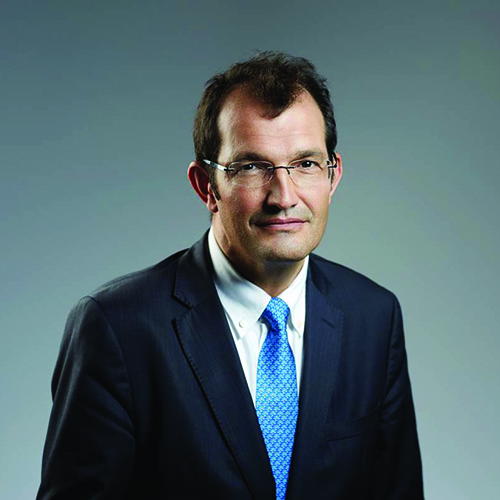

- Jean-Marc Servat
- Chair, EACT
Introducing the new EACT Chairman...
TMI is delighted to welcome this first column from the newly appointed Chairman of EACT, Jean-Marc Servat. He was for five years the International Treasurer of Cisco Systems, prior to setting up his own boutique consulting activity. He formerly led the Treasury team of Lukoil’s oil trading company. Previously, he was Director of FX Structuring at Citibank in London, headed Nokia’s global Foreign Exchange risk management and held various financial positions with Dow Chemical. He is a graduate of HEC business school in Paris.
Jean-Marc was the president of the Swiss Treasury Association ACTSR, and is a board member of the Association.
EMIR, or the Long Run of Corporate Treasurers
by Jean-Marc Servat, Chairman, EACT
 In my teenage days, I always loved seeing marathon runners enter the stadium and complete the 42 km race. But it was only when I ventured into amateur long distance running that I truly admired those runners and understood how one can enjoy getting closer to the finish line, accepting the pain, kilometer after kilometer, and the sense of achievement.
In my teenage days, I always loved seeing marathon runners enter the stadium and complete the 42 km race. But it was only when I ventured into amateur long distance running that I truly admired those runners and understood how one can enjoy getting closer to the finish line, accepting the pain, kilometer after kilometer, and the sense of achievement.
We, treasurers, thought we had gone through the EMIR finish line when hedging transactions were exempted from the clearing threshold calculations. It was recognition that hedging reduced risk and that the industrial and commercial economy did not create systemic risk.
On August 13, we were reminded that the race does not end at 42.195km. On that date, the European Securities and Markets Authority (ESMA) responded to the Commission consultation on EMIR. ESMA’s document presented informative data from trade repositories, but drew an unexpected conclusion. ESMA recommended removing the hedging exemption of non-financial counterparties and use other criteria, not specified, to assess the systemic importance of NFCs.
On August 13, I realised that my predecessor, Richard Raeburn, had just handed the baton to me, and that I was starting another long run.
One of the core messages of corporate treasurers and the EACT has been to highlight that treasurers use derivatives to hedge and do not open positions in the market. Hedging removes risk from the system by allowing corporations to focus on their core business and insulating it from financial markets. Treasury associations have claimed that corporations do not pose systemic risk. Trade repositories’ data seem to confirm that insight. According to ESMA’s report, NFC counterparties account for 72% of the counterparties but only 2% of the notional amount (9 trn out of a total of 608 trn EUR).
EACT and other associations are also pressing the Commission to accept single side reporting, claiming that financial counterparties are parties to most transactions and the reporting of transactions by NFC is an unnecessary burden. Here again, the data seems to confirm our opinion. For interest rate derivatives, 96% of transactions (based on notional amounts) are conducted between two financial corporations, and 4% between an NFC and a FC. This means that 0% (rounding) of derivatives is transacted between two NFC. Therefore, all IR transactions would be captured if only FC would report. For foreign exchange derivatives, only 3% of transactions occur between two NFCs. This means that at least 97% of notional volumes would be reported if the reporting obligations would be limited to financial counterparties.
We understand and share the objective of reducing systemic risk, but we believe that the data shows that the additional burden put on the industrial and commercial economy is not justified.
ESMA’s challenging the hedging criteria seems to come from a concern of what it calls ‘large NFC-‘. These are non-financial corporations that classify most of their transactions as hedges, and are therefore below the clearing threshold. The regulating authority has identified a small number of such large NFC- that have a large notional amount of transactions. Looking at the report (page 26 of http://tiny.cc/cnz02x), it seems the concern comes from one or two large NFC- active in the commodity sector. We would advocate a dialogue between ESMA and the – unnamed – firm(s) to better assess the risk. Changing the rules and creating additional burden for more than 100 000 NFCs because of concern over one or two seems inefficient. In addition, we would add that these very large NFC- have been identified.
Treasurers are financial professionals. We like data and can be convinced by facts. We welcome the data provided by ESMA, but recommend further analysis and dialogue at this stage because we believe the recommendations are not balanced and backed by evidence.
In February 2015, the EBA had expressed some concerns about transactions exempted from the CVA (Credit Value Adjustments). Here again, we believe that the EBA failed to appreciate the risk-reducing impact of hedging transactions, and the sectorial diversification of NFCs. In both cases, the regulators still tend to evaluate financial transactions of corporations with the same criteria as the ones of financial organisations. This is a mistake because hedging transactions reduce systemic risk.
We will continue running long distance for better financial regulation because Europe needs a well-regulated financial system and corporate treasurers are at the interface between the real economy and the financial world.









